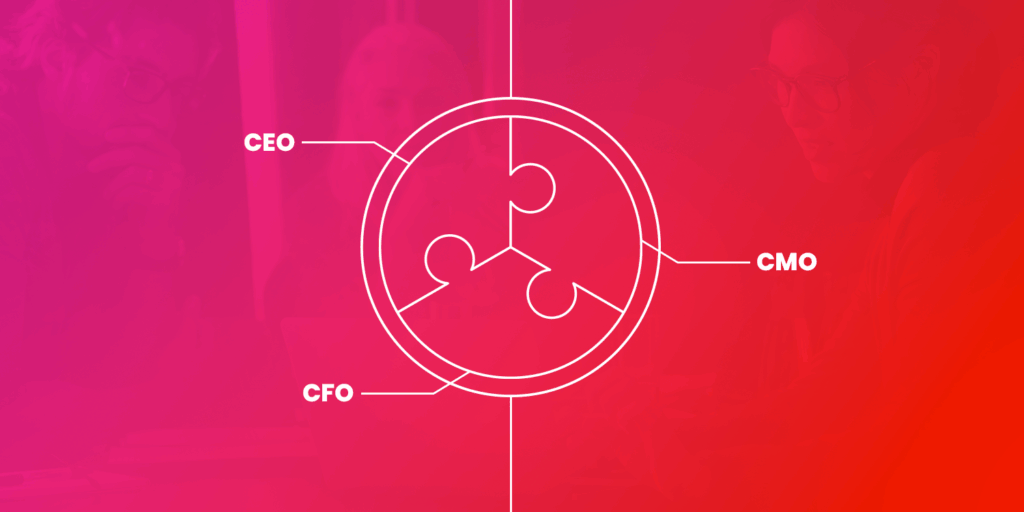In today’s rapidly shifting business climate, companies must actively drive sustainable business growth. It requires precision, vision, and, most importantly, alignment. I call them the “power trio,” and when they work together, they create unstoppable momentum.
Breaking Down Silos to Drive Growth
Too often, these three leaders operate in silos: the CEO sets the vision, the CMO drives marketing strategy, and the CFO monitors the bottom line. But when these roles work together with clarity and trust, they become a growth engine that fuels company-wide momentum.
Strategic alignment between leadership roles helps eliminate miscommunication, increase operational efficiency, and ensure that marketing investments align with financial goals —key components of driving sustainable business growth.
Casting the Vision, Executing the Strategy, Stewarding the Resources
At its core, alignment starts with a shared understanding:
- The CEO casts the vision — setting the destination and defining what success will look like
- The CMO builds the roadmap — translating that vision into strategic marketing campaigns that engage customers and generate revenue.
- The CFO safeguards the resources — ensuring that every investment supports the vision and moves the business closer to its goals.
Each role brings unique strengths, but real impact occurs when they work together as one. Strategy needs execution, and execution needs alignment. When the CEO, CMO, and CFO work in sync, bold ideas gain traction and marketing investments deliver measurable ROI.
The High Cost of Misalignment
When the power trio falls out of sync, organizations pay the price in lost time, missed opportunities, and wasted resources. I’ve seen companies spend months debating strategy instead of executing it—by the time decisions are made, competitors have advanced, market openings have closed, and teams have lost momentum.
At The Point Group, a Dallas-based integrated marketing agency, we help leaders prevent that kind of stall by prioritizing alignment early in the planning process. We guide clients to initiate strategic discussions in the third quarter, ensuring their teams enter the new year prepared to move quickly with clear priorities, approved budgets, and the energy to execute.
Why Marketing Deserves a Seat at the Table
Despite its critical role in growth, marketing is still often underrepresented in boardroom conversations. Part of the challenge is the fragmented nature of media today: traditional, digital, social, experiential, and now AI.
No one has all the answers, but one thing is clear: marketing must be part of every growth conversation from the start.
Marketing is most effective when measured by the business outcomes it drives, rather than just vanity metrics like impressions or clicks. At The Point Group, we approach marketing as a strategic growth driver, aligning campaigns with the CEO’s vision while supporting the CFO’s financial priorities. For CMOs, this means connecting marketing investments to measurable business results.
Building Trust: The Foundation of the Power Trio
Alignment can’t happen without trust. When the CEO, CMO, and CFO trust each other, they can debate openly, challenge assumptions, and still move forward as a cohesive team. Healthy conflict sharpens ideas, but trust ensures that disagreements don’t fracture the team.
Trust also grows from understanding the whole person, not just the role. At The Point Group, I make a point to know my leaders beyond their titles: their motivations, pressures, and even their families. When people feel genuinely understood and supported, they are more resilient in the face of challenges and more courageous in pursuing ambitious goals.
Planning as a Strategic Advantage
At The Point Group, we view strategic planning as one of the most valuable opportunities to drive business growth. Effective planning takes time, focus, and honest discussion about what’s working, what isn’t, and where to invest next.
”Alignment can’t happen without trust. When the CEO, CMO, and CFO trust each other, they can debate openly, challenge assumptions, and still move forward as a cohesive team. Healthy conflict sharpens ideas, but trust ensures that disagreements don’t fracture the team.
Susan OwenCEO
For plans to drive real impact, strategy, execution, and measurement must be connected, and every leader involved needs a shared understanding of what success will look like. Approaching planning this way gives your team a competitive advantage, rather than treating it as an annual formality.
Modeling Confidence and Cohesion
Confident and cohesive leadership teams attract businesses and customers. Confidence is visible. It is evident in how leaders communicate, collaborate, and present themselves. Executing plans is only part of the job; leaders also need to project belief in those plans. That visible conviction builds trust with employees, partners, and customers alike.
I also believe in teaching as you lead. Every leader should be lifting the next generation, sharing knowledge, encouraging curiosity, and modeling what outstanding leadership looks like. At The Point Group, some of my best insights come from the youngest members of our team. Leadership is a two-way street, and staying open to learning is essential for remaining innovative.
The Point of It All
For over 30 years, The Point Group has helped companies accelerate business growth through integrated marketing, brand strategy, public relations, digital marketing, and media planning. Our team brings experience from both the client and agency sides, and we use that expertise to drive results locally, nationally, and globally.
That perspective is why I believe in the power trio so strongly. When the CEO, CMO, and CFO are aligned, marketing plans drive the business forward and transform vision into momentum.
That’s the power of alignment. And it’s how growth really happens.
Taken from Episode 7 of the What’s the Point podcast, re-written and condensed by Theresa Hunt for clarity. Click above to watch the full version of the conversation with Susan Owen.










